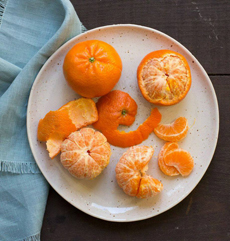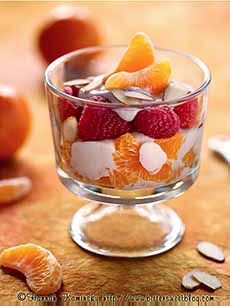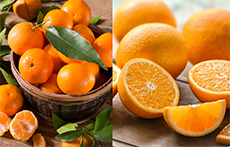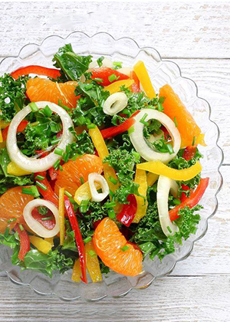Halos Mandarins, Plus Mandarins Vs. Oranges, The Difference
|
|
April is the end of the season for the sweet little mandarins called Halos, a brand name for clementines.
We’ve been enjoying them by the bagful. In addition to flavor and nutrition, they keep us from eating refined sugar snacks. They deserve their halo! > February 15th is National Clementine Day. > The difference between mandarins and oranges is below. > Also below, the history of mandarins. > The year’s 40+ citrus holidays. > All the fruit holidays (80 of them!) The fruit aisle can be confusing. Depending on the store, you can find clementines, Cuties, Halos, Dimples, tangerines and mandarin “oranges.” Nota bene: mandarins are not oranges, but a different species. More about that in a minute. Welcome to the world of single-serving, easy to peel, sweet and juicy—and branded—citrus. Halos, Cuties, and Sweeties are mandarins from California, different brand names for what are often clementines. Don’t call them mandarin oranges! While both are from the genus Citrus, mandarins are a different species, just like broccoli and cabbage—both members of the genus Brassica—are different species. Here’s the difference (Produce Pete and Wikipedia take note!). > Yummy ways to use mandarins are below, along with some good tips. From a hybridization perspective, the mandarin is a progenitor of the orange*. The orange is a cross between a mandarin and a pomelo, created long ago in China. From a visual perspective: |
|
|
WHAT ARE THE DIFFERENT CLEMENTINE NAMES ALL ABOUT? Why the different names? Branding! The names are not varieties, but trademarked names, encouraging the consumer to look specifically for Cuties or Halos. |
||
|
Now for a twist: Like oranges, mandarins are very versatile. The first thing anyone would think of is hand fruit. The term refers to fruits small enough to eat from the palm of your hand, such as apples, pears and stone fruits—but not pineapples or other fruits that need to be cut up. But why stop there? Use luscious mandarins: |
|
|
|
THE HISTORY OF MANDARINS Thanks to Etienne Rabe, Vice President, Agronomy, for Wonderful Citrus, for this history of mandarins: It’s difficult to pinpoint the exact origin of the name, but we know that mandarins were grown for many centuries in China. The first mandarin tree was brought to England from China in 1805, and its progeny went from England to Malta, then to Sicily and continental Italy. Little information is available about mandarins in Chinese literature, but as far back as 1178 C.E., Chinese author Han Yen-chih described 27 different varieties of mandarins. The clementine originated in North Africa and made their way to Morocco in the 1960s and Spain in the 1970s. Spain started exporting them to the East Coast of the U.S. in the 1990s. The murcott variety was bred in Morocco and introduced to the U.S. in the mid-1990s. As imported clementines became popular, American citrus growers saw the potential of the fruit…and how lucky we are! *The binomial classification of both mandarins and oranges branches at the species level. Both are in the genus Citrus. The pomelo is also a member of the Citrus genus. Its species is Citrus maxima. The entire taxonomy: Kingdom Plantae, Clade Tracheophytes, Clade Angiosperms, Clade Eudicots, Clade Rosids, Order Sapindales, Family Rutaceae, Subfamily Auranntioideae, Tribe Citreae, Subtribe Citrinae, Genus Citrus. CHECK OUT WHAT’S HAPPENING ON OUR HOME PAGE, THENIBBLE.COM. |
||








